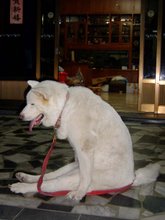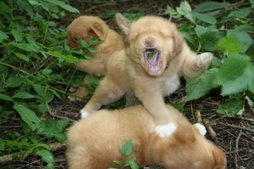Digging - how to stop Part I
Digging is a common and very normal behavior for dogs. As with all problems, it is important tounderstand the reasons behind the behavior. With digging there are many motives. Dogs dig because they are bored. They dig when it is hot because they like to lie in holes to get cooler. They dig to escape. They bury objects. Sometimes dogs simply dig because they like to.
In dealing with a digging problem, first understand that every dog has a certain amount of energy to expend each day. Sufficient exercise is often an excellent way to burn off excess energy and frequently helpsin curtailing digging behavior.
You must remember, exercise programs will vary from breed to breed and dog to dog, so check with your veterinarian. Also remember that simply leaving your dog alone in the yard does not count as exercise. You must exercise the dog!
You need to giveyour dog things to do that are more interesting to him than digging holes.
Tere are a number of creative toys that can keep most dogs occupied and interested. Consider toys like a Buster Cube or Boomer Ball.
The Buster Cube is a plastic square that you can put small pieces of food in. The dog can get the food, but only after shaking and moving the cube around. This will keep many dogs focused for
hours.
Boomer Balls are hard plastic balls that some dogs love to chase around. They are generally too large for most dogs to fit in their mouths, although many dogs will certainly try. Some dogs will bat at the ball with their paws, push it around the yard with their chests and have a great time playing ball and not digging holes.
Make it a point to play with your dog and these toys in the yard.
Doing this will get the dog interested in the toys and teach him there are other fun activities in the yard besides digging. Nylabones, Kongs, and Rhino toys will also focus your dog on something other than digging.














3 comments:
Dog Obedience Training can play a huge role in how your dog acts. Great post. Keep up the great work!
Great tips on dog training! Thanks!
I understand my dog a little better after reading this. Thank you!
Post a Comment